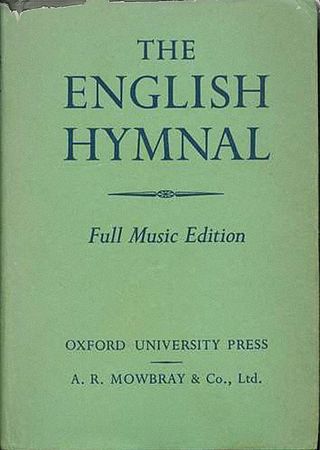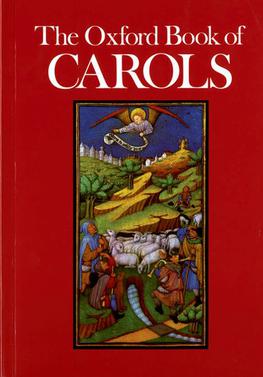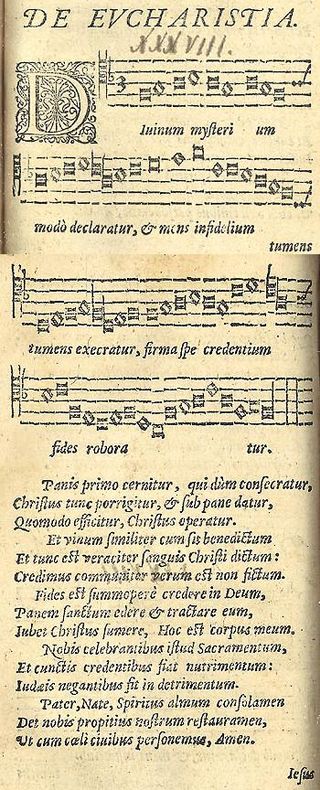
A Christmas carol is a carol (a song or hymn) on the theme of Christmas, traditionally sung at Christmas itself or during the surrounding Christmas and holiday season. The term noel has sometimes been used, especially for carols of French origin. Christmas carols may be regarded as a subset of the broader category of Christmas music.
A carol is a festive song, generally religious but not necessarily connected with Christian church worship, and sometimes accompanied by a dance. A caroller is someone who sings carols, and is said to be carolling.

Sir John Milford Rutter is an English composer, conductor, editor, arranger, and record producer, mainly of choral music.

"Hark! The Herald Angels Sing" is an English Christmas carol that first appeared in 1739 in the collection Hymns and Sacred Poems. The carol, based on Luke 2:14, tells of an angelic chorus singing praises to God. As it is known in the modern era, it features lyrical contributions from Charles Wesley and George Whitefield, two of the founding ministers of Methodism, with music adapted from "Vaterland, in deinen Gauen" of Felix Mendelssohn's cantata Festgesang.

"Away in a Manger" is a Christmas carol first published in the late nineteenth century and used widely throughout the English-speaking world. In Britain, it is one of the most popular carols; a 1996 Gallup Poll ranked it joint second. Although it was long claimed to be the work of German religious reformer Martin Luther, the carol is now thought to be wholly American in origin. The two most common musical settings are by William J. Kirkpatrick (1895) and James Ramsey Murray (1887).

The English Hymnal is a hymn book which was published in 1906 for the Church of England by Oxford University Press. It was edited by the clergyman and writer Percy Dearmer and the composer and music historian Ralph Vaughan Williams, and was a significant publication in the history of Anglican church music.

"What Child Is This?" is a Christmas carol with lyrics written by William Chatterton Dix in 1865 and set to the tune of "Greensleeves", a traditional English folk song, in 1871. Although written in Great Britain, the carol today is more popular in the United States than its country of origin.

Once in Royal David's City is a Christmas carol originally written as a poem by Cecil Frances Alexander. The carol was first published in 1848 in her hymnbook Hymns for Little Children. A year later, the English organist Henry Gauntlett discovered the poem and set it to music.

The New Oxford Book of Carols is a collection of vocal scores of Christmas carols. It was first published in 1992 by Oxford University Press (OUP) and was edited by Hugh Keyte and Andrew Parrott. It is a widely used source of carols in among choirs and church congregations in Britain.

Percival Dearmer was an English Anglican priest and liturgist best known as the author of The Parson's Handbook, a liturgical manual for Anglican clergy, and as editor of The English Hymnal. A lifelong socialist, he was an early advocate of the public ministry of women and concerned with social justice. Dearmer, with Ralph Vaughan Williams and Martin Shaw, helped revive and spread traditional and medieval English musical forms. His ideas on patterns of worship have been linked to the Arts and Crafts Movement, while The English Hymnal reflects both folkloric scholarship and Christian Socialism. At his death, he was a canon of Westminster Abbey, where he ran a canteen for the unemployed.

"Es ist ein Ros entsprungen" is a Christmas carol and Marian hymn of German origin. It is most commonly translated into English as "Lo, how a rose e'er blooming" and is also called "A Spotless Rose" and "Behold a Rose of Judah". The rose in the German text is a symbolic reference to the Virgin Mary. The hymn makes reference to the Old Testament prophecies of Isaiah, which in Christian interpretation foretell the Incarnation of Jesus, and to the Tree of Jesse, a traditional symbol of the lineage of Jesus. Because of its prophetic theme, the hymn is popular during the Christian season of Advent.

The Oxford Book of Carols is a collection of vocal scores of Christmas carols and carols of other seasons. It was first published in 1928 by Oxford University Press and was edited by Percy Dearmer, Martin Shaw and Ralph Vaughan Williams. It became a widely used source of carols among choirs and church congregations in Britain.

"In dulci jubilo" is a traditional Christmas carol. In its original setting, the carol is a macaronic text of German and Latin dating from the Middle Ages. Subsequent translations into English, such as J. M. Neale's arrangement "Good Christian Men, Rejoice" have increased its popularity, and Robert Pearsall's 1837 macaronic translation is a mainstay of the Christmas Nine Lessons and Carols repertoire. J. S. Bach's chorale prelude based on the tune is also a traditional postlude for Christmas services.
Rocking or Rockin may refer to:

"Of the Father's heart begotten" alternatively known as "Of the Father's love begotten" is a doctrinal hymn based on the Latin poem "Corde natus" by the Roman poet Aurelius Prudentius, from his Liber Cathemerinon beginning "Da puer plectrum" which includes the Latin stanzas listed below.
"See, amid the Winter's Snow", also known as "The Hymn for Christmas", is an English Christmas carol, written by Edward Caswall and first published in 1858. In 1871 Sir John Goss composed a hymn tune for it, "Humility", and as "Hymn for Christmas Day", it was included in Christmas Carols New And Old, the anthology edited by Henry Ramsden Bramley and John Stainer.
"As with Gladness Men of Old" is an Epiphany hymn, written by William Chatterton Dix on 6 January 1859 (Epiphany) while he was ill in bed. Though considered by many as a Christmas carol, it is found in the Epiphany section of many hymnals and still used by many churches. The music was adapted by William Henry Monk in 1861 from a tune written by Conrad Kocher in 1838. The hymn is based on the visit of the Biblical magi in the Nativity of Jesus.

"The Three Kings", or "Three Kings From Persian Lands Afar", is a Christmas carol by the German composer Peter Cornelius. He set "Die Könige" for a vocal soloist, accompanied by Philip Nicolai's hymn "Wie schön leuchtet der Morgenstern", which he erroneously thought was an Epiphany hymn. In fact, it is an Advent hymn in which the morning star is an allegory for the arrival of Jesus, not the Star of Bethlehem. In Cornelius' original second setting, the accompaniment was played on a piano but the English organist Ivor Atkins later arranged the accompaniment for choir, with the choir singing the words of the original hymn. The German words have been translated into English by H.N. Bate. The carol describes the visit of the Biblical Magi to the Infant Jesus during the Nativity and is also used as an Epiphany anthem.

"The Babe in Bethlem's Manger", also called "The Babe in Bethlehem's Manger Laid", "Old Kentish Carol" and "The Saviour's Work", is an anonymous English folk Christmas carol celebrating the birth of Jesus in Bethlehem.
"Ye Choirs of New Jerusalem" or "Sing, Choirs of New Jerusalem" is an English Easter hymn by Robert Campbell. It is a 19th-century translation of the medieval Chorus novae Ierusalem, attributed to Fulbert of Chartres. The text's primary focus is the Resurrection of Jesus, taking the theme of Jesus as triumphant victor over death and deliverer of the prisoners from Hell.
















